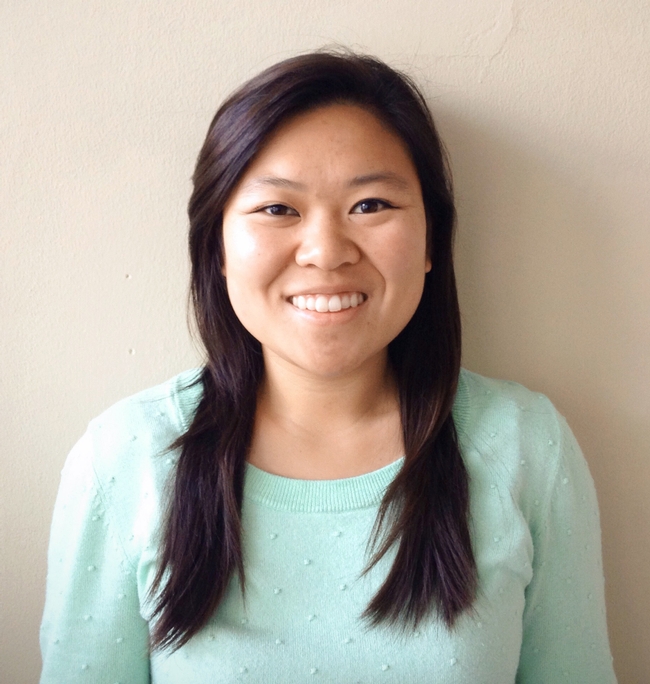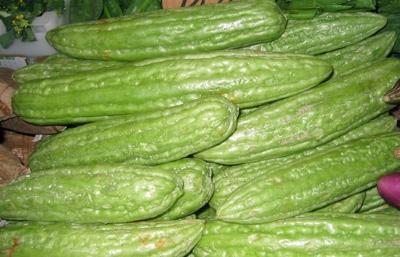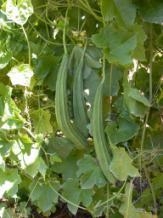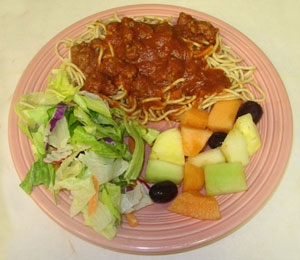Posts Tagged: Connie Schneider
UC students receive fellowships to study food issues
November 19, 2014
Pam Kan-Rice, (510) 206-3476, pam.kanrice@ucanr.edu
UC students receive fellowships to study food issues
Three University of California students will be working with scientists in the UC Division of Agriculture and Natural Resources (ANR) to study food security, nutrition education and agricultural research and extension as part of the UC President's Global Food Initiative Student Fellowships.
UC Berkeley senior Jacqueline Chang, UC Davis graduate student Samantha Smith and UC Berkeley doctoral candidate Kevi Mace-Hill each have been awarded a $2,500 fellowship.
The fellowships are supported by the UC Global Food Initiative, which UC President Janet Napolitano, together with UC's 10 chancellors, launched in July in an effort to help put UC's campuses, the state and the world on a pathway to sustainably and nutritiously feed itself. The UC Office of the President is providing $7,500 to each UC campus, ANR and Lawrence Berkeley National Laboratory for the fellowships, which will be awarded to both undergraduate and graduate students, with funds allotted at each campus's discretion in three $2,500 portions.
"Student involvement is critical to carrying forward UC's work to improve food security for UC students and others in California and beyond," said Barbara Allen-Diaz, UC vice president for Agriculture and Natural Resources. "These Global Food Initiative Student Fellowships will enable UC students Jacqueline Chang, Kevi Mace-Hill and Samantha Smith to work with UC scientists who study the food system and provide the latest research findings to farmers and consumers. Working together, we can continue improving access to nutritious foods."
Jacqueline Chang, UC Berkeley
Chang will work with Lorrene Ritchie, director of UC ANR's Nutrition Policy Institute, on a food security research project. The UC Berkeley senior, who is majoring in nutritional science with an interest in food insecurity, will assist in developing and conducting a survey to assess the prevalence of hunger and inadequate access to food among UC students across all 10 campuses. She will write a report and present the survey findings to Napolitano in the spring. Chang, a native of the Southern California community of San Marino, has worked with the Berkeley-based organization Feeding Forward to raise awareness of hunger, food insecurity and food waste.
Samantha Smith, UC Davis
Smith, a public health graduate student at UC Davis, with direction from Connie Schneider, director of UC ANR's statewide Youth, Families and Communities Program, will interview UC scientists about their research and extension efforts in agriculture, food and nutrition statewide and capture their stories to share with the public via blogs and social media. Smith, a native of Pleasanton, earned a bachelor's degree in psychology from Sonoma State University and is a California Wellness Foundation Fellow.
Kevi Mace-Hill, UC Berkeley
Mace-Hill will lead a group of graduate students that organizes seminars and workshops for students interested in careers in Cooperative Extension. Their goal is to improve graduate student preparedness for extension, outreach and applied research. Her fellowship will support the UC Berkeley graduate student-led Cooperative Extension Showcase.
The annual event brings UC Cooperative Extension advisors and specialists who conduct research and extension in nutrition, youth development, agriculture and natural resources to the Berkeley campus to discuss their work and network with graduate students. At the showcase in the spring, students will have an opportunity to meet potential mentors. Mace-Hill, a native of LaVeta, Colo., earned her bachelor's and master's degrees in biology at Wesleyan University in Connecticut and is currently pursuing her Ph.D. in biological pest control at UC Berkeley.
Through its Global Food Initiative, UC is building on existing efforts and creating new collaborations among its 10 campuses, affiliated national laboratories and ANR to improve food security, health and sustainability.

GFI fellows
UCCE makes Southeast Asian vegetables easy to eat
Most Americans gravitate toward the familiar in supermarket produce aisles. But some creative shopping unveils a tremendous diversity of edible vegetables that can turn an ordinary menu into a much more interesting cuisine.
At certain roadside stands, at farmers markets that cater to diverse clientele and in small Asian supermarkets, adventurous Californians can buy vegetables like bitter melon, Chinese long beans, opo and luffa. Finding them is the first step, knowing how to prepare them is another matter. UC Cooperative Extension has made these less familiar vegetables more accessible by creating a collection of easy-to-cook and nutritious Southeast Asian vegetable recipes.
The recipes were developed by UCCE nutrition educators in Fresno and the statewide UC Expanded Food and Nutrition Education Program team with Richard Molinar, a UCCE advisor in Fresno County. Connie Schneider, director of the UC Youth, Families and Communities Program, and Molinar started by researching the traditional usage of Asian vegetables. They modified some ingredients and procedures in the recipes to simplify preparation and improve the nutritional profile.
“We minimized the number of ingredients in each recipe, added clear measurements and tested the dishes,” Schneider said. “They are delicious.”
For the last 18 years, Molinar has worked with small-scale farmers in Fresno County, which boasts the largest concentration of Hmong farmers in the U.S. Fresno County is also home to farmers of other ethnicities from Laos, China and Vietnam. Molinar and his assistant, Michael Yang, have introduced Southeast Asian immigrant farmers to the latest farming technologies, helped them develop plans to ensure the safety of the food they grow, and worked with them to find new marketing opportunities. Many of these farmers have begun growing vegetables common in California, and most have also kept some space on the farm for the vegetables of their homelands.
The UCCE educators recognized that the rich culinary traditions of local Southeast Asian immigrants could be adapted and used by people of all cultures to increase their consumption of vegetables. Besides, encouraging consumption of Southeast Asian vegetables adds new marketing opportunities for the farmers.
“This has been a unique opportunity to bring UCCE’s farm advisors and nutrition educators together to assist farmers and the public,” Molinar said. “These recipes will encourage more people to buy these nutritious vegetables, expanding the market for the growers.”
The 12 recipes are printed on cards, each with photos of the fresh vegetable and background information. For example, the recipe card for “bitter melon stir fry” notes that the crinkly skinned vegetable is native to India and is eaten when young and green, as bitterness increases with age. The recipe is accompanied by a photo of the prepared dish and complete nutrition facts per serving.
Most people are familiar with luffa after it has dried into a natural scrubby. It is often found near beauty products in stores and purchased to exfoliate the skin. However, the UCCE recipe card for “luffa and prawns” notes that fresh green luffa has a similar but sweeter flavor than zucchini summer squash when stir fried. Either the smooth or angled varieties of luffa can be used in the recipe.
"I grew up with zucchini," Molinar said, "but I prefer the flavor and texture of angled luffa."
The printed cards will be distributed at farmers markets where Southeast Asian vegetables are sold, and they are available on the Fresno County UC Cooperative Extension website. Farmers who sell Asian vegetables at farmers markets may pick up 10 packets of recipes for free at the UC Cooperative Extension in Fresno, 1720 S. Maple Ave., Fresno. Direct links to each of the recipes are below:
- Bitter Melon Stir Fry
- Chinese Long Bean and Tofu Salad
- Chinese Winter Melon Chicken Soup
- Field of Greens Salad
- Fuzzy Gourd Stuffed with Pork and Mushrooms
- Lemongrass Chicken Soup
- Luffa and Prawns
- Marinated Japanese Eggplant
- Opo and Beef
- Snow Pea Daikon Salad
- Strawberry Spring Rolls
- Spicy Shrimp and Bok Choy Noodle Bowl
Following are two sample recipes:
Bitter Melon Sir Fry
Serves 4
Ingredients:
1 ripe bitter melon, seeded and sliced
1 tablespoon olive oil
1 onion, diced
3 garlic cloves, crushed
½ lb. ground pork
½ lb. medium shrimp, peeled and deveined
1 tomato, chopped
1 tablespoon reduced sodium soy sauce
Pepper to taste
Directions:
- Place sliced bitter melon in boiling water until just tender (2-3 minutes). Drain
- Heat olive oil in skillet over medium heat. Sauté onions for about 5 minutes until tender.
- Add garlic; sauté an additional 2 minutes; mix in pork and cook until no longer pink.
- Add shrimp; cook about 5 minutes until done.
- Add tomato, bitter melon, and soy sauce; cook until tender.
Luffa and Prawns
Serves 4
Ingredients:
1 tablespoon vegetable oil
1 garlic clove, minced
1 lb large prawns, peeled and deveined
2 luffa (angled luffa or smooth luffa), chopped
¼ cup bamboo shoots
1 teaspoon coriander
1 tablespoon reduced sodium soy sauce
1 green onion, sliced
Directions:
- Heat oil in a wok/pan; add garlic and stir fry for 1 minute.
- Add prawns; cook until done
- Add luffa; continue to stir fry with prawns until just tender, about 5 minutes.
- Add bamboo shoots, coriander, and soy sauce to pan and stir fry a few minutes
- Sprinkle with green onion and serve.
National Nutrition Month®
March is National Nutrition Month®! Thirty-eight years ago a week long campaign to promote nutrition was launched by the American Dietetic Association. That same campaign gained public popularity and has since expanded to what is now known as National Nutrition Month®. This March the theme is “Eat Right with Color.” The American Dietetic Association (ADA) recommends:
Start with the basics. Use MyPyramid to build a healthy, balanced diet. Visit www.mypyramid.gov for your personalized food plan.
Nutrient-dense foods. The ADA also suggests focusing foods that are rich in vitamins and minerals and lower in calories and fat. For example, whole grain toast with low-fat cheese, fruit, and a cup of coffee with low-fat milk will provide more nutrients than a muffin and a coffee drink filled with sugared syrup and whipped cream. Try the yummy National Nutrition Month recipes, which will satisfy your taste buds and your body’s craving for nutrients!
Variety is important. Varying the foods you consume will ensure you are getting all the nutrients that your body needs. Aim to build a rainbow on
your plate!
Make the most of family meal-time. The eating habits children learn today are the habits they will have tomorrow. Model healthy eating habits with children to help them make healthy choices.
Physical activity is important for “managing weight and overall health.” MyPyramid encourages at least 30 minutes per day.
These five key messages are at the core of all the events taking place during National Nutrition Month®. Activities in different venues are put on by the ADA to spread nutrition awareness. In schools and at community centers there are activities and/or events taking place to celebrate National Nutrition Month®. For more information about events or activities or information in about National Nutrition Month®, click here.
Blog contributors: Connie Schneider, Ph.D., R.D., Kathleen Burke, CSUF Dietetic Intern, & Shelby MacNab, Nutrition Program Manager
National Nutrition Month 2011 Recipes

salad
EFNEP helps us eat well on the cheap
Last week (Jan. 31, 2011) the U.S. Department of Agriculture released its revised 2010 Dietary Guidelines for Americans. They are “the federal government's evidence-based nutritional guidance to promote health, reduce the risk of chronic diseases, and reduce the prevalence of overweight and obesity through improved nutrition and physical activity,” according to the press release.
I scanned the press release for news that cookies have been designated an essential food group. No luck. I confess, I didn’t read the entire 95-page pdf, but surely any such rocking revelations would have been reported in the press release.
Because more than one-third of children and more than two-thirds of adults in the United States are overweight or obese, the guidelines emphasize eating less and moving more.
I wasn’t surprised to see among its 23 key recommendations the advice to drink more water instead of sugary drinks, eat a variety of healthy foods and reduce salt. I expected the recommendation to eat more fruits and vegetables, but now it’s more explicit.
They say half of my plate should be covered in fruits and veggies. And mix it up – eat a variety of vegetables and protein sources. (I used to eat broccoli beef almost every day for lunch, until the day I found an insect in it.)
Many people think they have to spend more for nutritious meals, that fresh produce and meat are expensive. However, UC’s Expanded Food and Nutrition Education Program, or EFNEP, gives tips on how to make healthful food choices when you’re on a limited income. (Unless your name is Mark Zuckerberg, whose income isn’t limited?)
Chapter 6 of the Dietary Guidelines acknowledges that our environment – composed of school, workplace, social groups, culture and so on – influences our food and exercise choices. However, our communities don’t excuse our behavior because ultimately we make our own choices, it essentially says. We may have more access to healthy foods and opportunities to engage in physical activity than we realize. Connie Schneider, EFNEP Council chair, sees EFNEP as a vehicle to help families navigate their complicated food environments.
“Our educators facilitate group discussions to resolve food issues from shopping on a budget to getting their children to eat healthier foods,” said Schneider, who is also a UC Cooperative Extension nutrition advisor.
The EFNEP staff meets with families and children in a variety of community settings, including schools, shelters and transitional housing. Nutrition educators teach them how they can stretch their food dollars and still enjoy a healthy diet. They share recipes for nutritious meals that are simple to prepare as well as inexpensive. I love to eat, but have little patience for cooking. Watching a nutrition educator demonstrate how to make chili, I found myself thinking, “That’s so quick and easy, even I would do that.”
Sometimes a new way of preparing a familiar vegetable encourages me to eat more veggies.
The EFNEP website spotlights a Fresh Pick of the Month, such as cauliflower. The site gives the nutritional benefits of cauliflower, serving tips and recommendations for handling and storing the vegetable. It also provides a recipe for cauliflower soup.
The nutrition educators also publish monthly newsletters, in English and Spanish, featuring a recipe and healthful suggestions, such as walking to the restaurant and sharing entrees when you go out to eat. Although the nutrition program is designed to assist families and children whose resources are limited, we can all use the suggestions to improve our health and save some money.
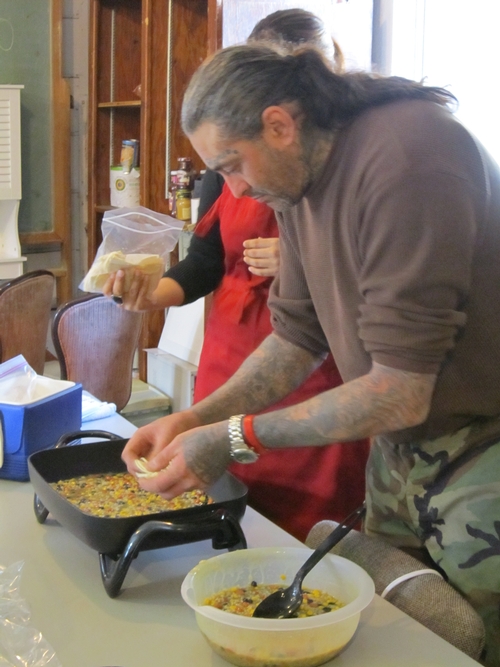
EFNEP enchilada casserole preparation
A new approach in teaching healthy eating
UC Cooperative Extension nutrition educators have discovered that, when it comes to teaching consumers how to eat right, a picture is worth of thousand words.
“We’ve been teaching people for years about MyPyramid and the dietary guidelines, serving sizes and the number of servings they should eat, but many were having a hard time translating that to what exactly to put on their plates,” said Cathi Lamp, the nutrition, family and consumer sciences advisor for Tulare County UCCE.
In an effort to simplify nutrition education, UCCE started with a graphic of a plate, with half designated for fruits and vegetables and a quarter each for protein and grains. However, the concept was still too abstract for concrete thinkers.
“Then we hit upon the idea of photographing familiar foods in the right proportions and showing actual serving sizes arranged on a plate,” Lamp said.
Lamp, and the nutrition, family and consumer sciences advisors for Fresno County, Connie Schneider, and Kern County, Margaret Johns, set out to review 24-hour recall surveys that had been conducted by participants in UCCE nutrition education classes. The 24-hour recall surveys, a mainstay in nutrition research, ask participants to write down everything they have eaten in the previous 24 hours. Each of the advisors focused on recalls from target population groups – Latinos, African-Americans and the general population.
Once they knew what foods people eat, Lamp, Schneider and Johns began the labor-intensive process of preparing and photographing test pictures showing healthy food combinations. Meals included chicken, pizza, spaghetti, sandwiches, tacos, pork chops, fish, stir fry, hamburger, soup and eggs.
Eighteen plates of food were photographed for initial, informal testing. Lamp took the photos to an education session at the local WIC office, where pregnant women and new mothers receive federal nutrition support.
“We handed out a little form and asked the moms if they could identify the foods, whether these were foods they would eat and, if not, what changes they would make,” Lamp said. “The WIC educators loved the images. They could see the value of images of healthy food right off the bat.”
The next step will be cognitive testing of the photos with target clientele, adjustment of the photos based on the results of the testing, retesting the photos in a nutrition education setting and analyzing the results.
Cathi Lamp explains food plate design process.

